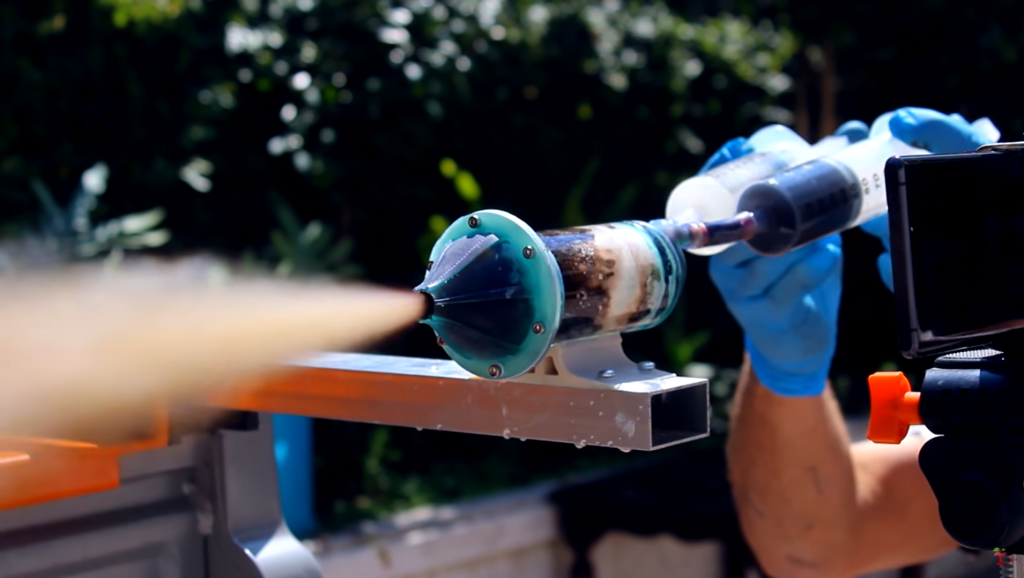The nominations for the 2021 3D Printing Industry Awards are now open. Who do you think should make the shortlists for this year’s show? Tell us now before next week’s deadline.
Tech YouTuber Integza has used 3D printing technology to develop a low-cost functional rocket engine inspired by an old, experimental Nazi design.
Based on the engine of a 1930s German aircraft called the Heinkel He 176, the 3D printed rocket engine doesn’t rely on burning fuel or combustion at all, instead generating its thrust via a volatile chemical reaction. Integza has attempted to build miniature rocket engines in the past, but the 3D printed components have always melted or broken in some way due to the use of heat. As it turns out, he just needed to turn to experimental Nazi technology to make his dream a reality.
Integza said, “I don’t think I can convey how happy I am about this. It’s the first time on a project that I 3D printed a rocket and by the end of the video, the rocket was still in one piece.”

The Heinkel He 176
In the world of modern aerospace, there are three conventional types of rocket engines: solid fuel, liquid fuel, and hybrid fuel (which combines solid and liquid). These engines all operate based on a tried and tested formula, where combustible fuel is mixed with an oxidizer and the subsequent bi-propellant mixture is burned to produce exhaust gases. The emission of these exhaust gases is what generates thrust.
German aircraft manufacturer Heinkel had a different idea when it developed the He 176, which uses a monopropellant rocket engine instead. Rather than burning fuel and an oxidizer, the He 176 relies on a high-energy chemical decomposition reaction to produce exhaust gases. In this case, the compound being decomposed is hydrogen peroxide, and the catalyst used to accelerate the reaction is potassium permanganate.

3D printing a monopropellant rocket engine
Integza’s rocket design is essentially a scaled-down, simplified version of the He 176’s, and even uses the same hydrogen peroxide/potassium permanganate combination for the decomposition reaction.
He said, “For starters, I needed to get a high concentration of hydrogen peroxide, because the ones they sell at the pharmacy only have 3% hydrogen peroxide and the rest is water. Eventually, I was able to find hydrogen peroxide with 50% concentration.”
The potassium permanganate was readily available on an agriculture website as it’s commonly used for water treatment purposes and as a disinfectant. Once he tested the compounds and found that the reaction was strong enough to generate sufficient thrust for a homemade rocket, it came time to design and 3D print the body of the engine on a resin-based desktop Elegoo system.
The first of the 3D printed components was the swirl injector, which served to inject and mix the peroxide and the permanganate in an acrylic tube (the ‘combustion’ chamber). The injector featured two individual channels, both of which sprayed the reactants in a conical pyramid shape for maximum mixing efficiency. Integza then 3D printed a convergent nozzle for the rear end of the engine, a geometry known to optimize thrust. Once assembled, the rocket was fired up on a stationary test bench in his backyard in spectacular fashion.
Integza concludes, “Overall, I’m really excited about all of this because I think I can make an actual rocket out of this reaction. And because the reaction generates steam, I can even integrate it with a steam engine, perhaps.”
3D printing content creators like Integza provide an accessible way for us to learn more about additive manufacturing and how it can enable otherwise impossible projects. Earlier this month, DIY technology YouTuber befinitiv used a low-cost 3D printer to turn a 50-year-old analog camera into a digital one. By swapping out the film canister of a vintage Cosina Hi-Lite DLR with a Raspberry Pi and its 3D printed housing, he was able to capture full HD images and record videos, as well as live-stream his videos to his computer over Wi-Fi.
Elsewhere, 3D printing YouTuber Teaching Tech designed and 3D printed his own open-source version of a rare antique fractal vise. Dubbed ‘the coolest tool you didn’t know you needed’, the 100-year-old fractal vise is near impossible to purchase these days, and is capable of morphing to grip virtually any object, regardless of the complexity of the geometry.
Subscribe to the 3D Printing Industry newsletter for the latest news in additive manufacturing. You can also stay connected by following us on Twitter, liking us on Facebook, and tuning into the 3D Printing Industry YouTube Channel.
Looking for a career in additive manufacturing? Visit 3D Printing Jobs for a selection of roles in the industry.
Featured image shows Integza testing his 3D printed rocket engine. Photo via Integza.



